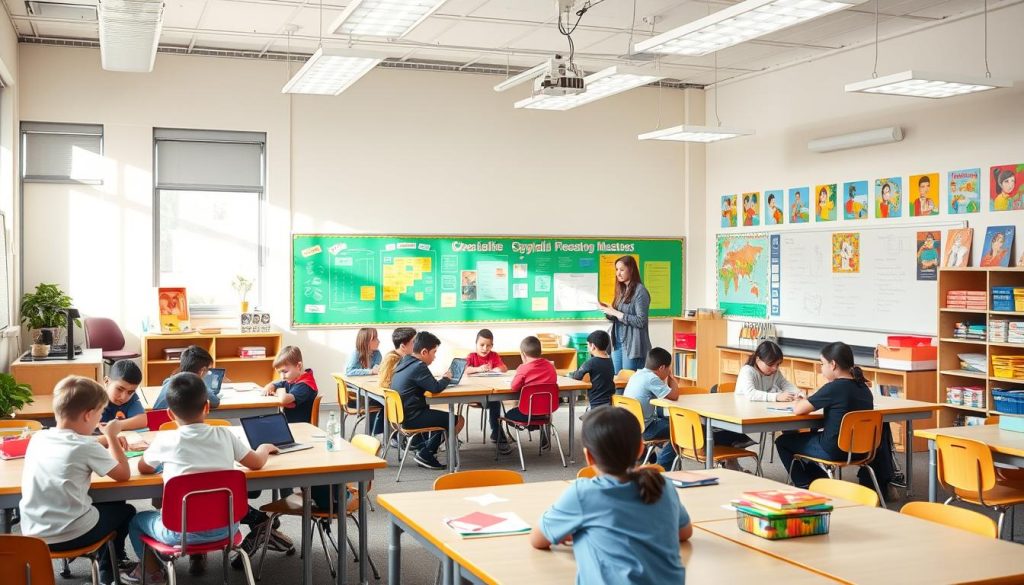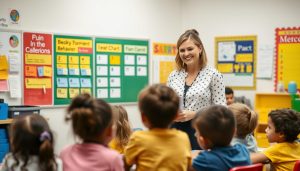Why Differentiation Strategies Matter in Modern Classrooms
Today’s classrooms are more diverse than ever before. Students come with different cultural backgrounds, learning preferences, readiness levels, and interests. According to research by Carol Ann Tomlinson, a leading authority on differentiated instruction, when teachers adjust their teaching to account for these differences, students learn more effectively and develop greater motivation for learning.
Differentiation strategies matter for several compelling reasons:
- They help meet the needs of all learners, including those with learning disabilities, English language learners, and gifted students
- They increase student engagement by connecting learning to students‘ interests and experiences
- They promote higher achievement by ensuring appropriate challenge for all students
- They develop student agency and ownership of learning
- They create more equitable learning environments where all students can succeed
Research consistently shows that classrooms where differentiation strategies are effectively implemented see improvements in student achievement, motivation, and classroom behavior. A study published in the Journal of Educational Research found that students in differentiated classrooms showed significantly higher growth in reading skills compared to those in more traditional settings.
Understanding the Core Principles of Differentiation Strategies
Before diving into specific techniques, it’s important to understand the foundational principles that guide effective differentiation. According to Carol Ann Tomlinson’s framework, differentiation can occur in four main areas:
Content Differentiation
What students learn and access to knowledge
- Varying reading materials by complexity
- Providing content at multiple levels
- Using supplementary materials
- Offering content in multiple formats (text, audio, visual)
Process Differentiation
How students make sense of content
- Tiered activities with varying complexity
- Flexible grouping strategies
- Providing choice in how to explore concepts
- Varying time allocations for tasks
Product Differentiation
How students demonstrate learning
- Offering multiple assessment options
- Creating product menus for student choice
- Varying complexity of final products
- Providing rubrics with tiered expectations
Learning Environment Differentiation
The classroom’s physical and psychological elements
- Flexible seating arrangements
- Creating quiet spaces and collaborative areas
- Establishing clear routines with flexibility
- Fostering a growth mindset culture
Effective differentiation is proactive rather than reactive. It’s not about creating 25 different lesson plans, but rather designing learning experiences with built-in flexibility that can accommodate diverse needs. The goal is to maximize each student’s growth by meeting them where they are and helping them progress.
In this video, Carol Ann Tomlinson explains the key principles of differentiation and how they can be applied in the classroom. As you watch, consider how these principles might apply to your specific teaching context.
Pre-Assessment: The Foundation of Effective Differentiation Strategies
Successful differentiation begins with knowing your students. Pre-assessment provides critical information about students‘ readiness, interests, and learning profiles that allows you to tailor l effectively.
Types of Pre-Assessment Tools
Readiness Assessments
- KWL charts (Know, Want to know, Learned)
- Entrancesse tickets with key concept questions
- Quick quizzes on prerequisite skills
- One-minute writing samples
Interest Inventories
- Student surveys about topic preferences
- Interest-based discussion prompts
- Choice boards to reveal preferences
- Multiple intelligence questionnaires
Learning Profile Assessments
- Observations of work habits
- Self-reflection on learning preferences
- Interviews about past learning experiences
- Analysis of previous work samples

Pre-assessment doesn’t need to be time-consuming or formal. Simple strategies like thumbs up/down checks for understanding, exit tickets from previous lessons, or quick digital polls can provide valuable information for planning differentiated instruction.
Using Pre-Assessment Data Effectively
Once you’ve gathered pre-assessment data, use it to:
- Form flexible groups based on readiness, interest, or learning profile
- Determine appropriate entry points for different students
- Identify students who may need additional support or extension
- Select appropriate resources and materials for different learners
- Design tiered activities that match students‘ current levels
“Assessment is today’s means of understanding how to modify tomorrow’s instruction.”
Carol Ann Tomlinson
Remember that pre-assessment is not about labeling students or creating fixed groups. It’s about gathering information that helps you make instructional decisions that will best support each student’s growth.
Content Differentiation Strategies for Diverse Learners
Content differentiation involves modifying what students learn based on their readiness, interests, and learning profiles. The goal is not to lower expectations for some students, but to provide appropriate entry points and pathways to the same essential understandings.
Strategies for Differentiating Content
Tiered Texts and Resources
Provide reading materials at different complexity levels that address the same concepts. Resources like Newsela and ReadWorks offer texts at multiple reading levels on the same topics.
Compacting Curriculum
Allow students who demonstrate mastery to skip practice on concepts they already know and move to more challenging material or independent projects related to the topic.
Concept-Based Teaching
Focus on big ideas and essential questions that all students explore, but allow for different depths of investigation based on readiness.
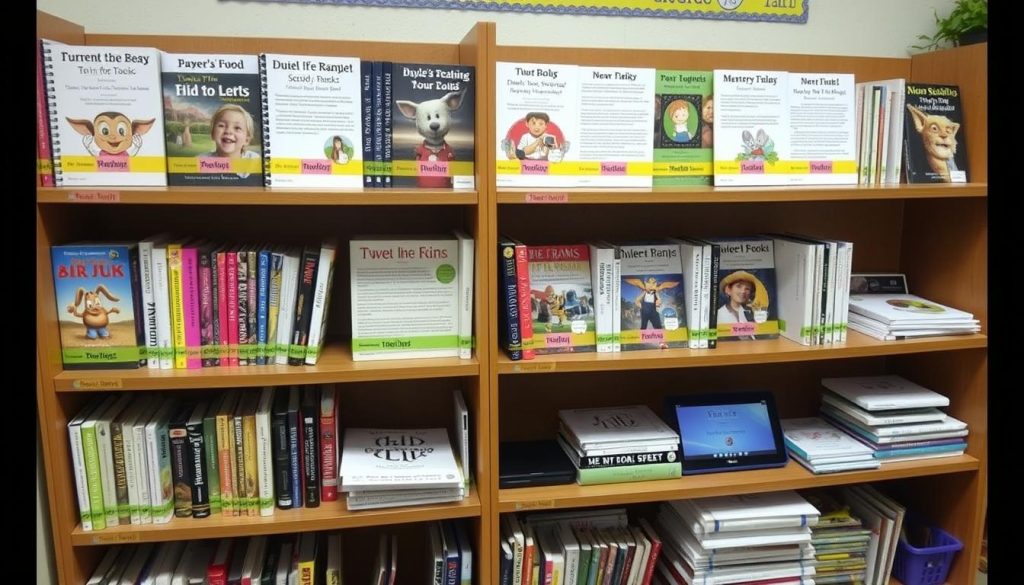
Example: Differentiating a Reading Lesson
| Student Group | Content Modification | Resources Provided |
| Approaching Grade Level | Simplified text with key vocabulary highlighted; audio support available | Graphic organizers, vocabulary cards, text-to-speech tools |
| At Grade Level | Grade-level text with guided reading questions | Note-taking templates, discussion prompts |
| Beyond Grade Level | More complex text with additional primary sources | Analytical frameworks, extension questions |
Digital Tools for Content Differentiation
Technology can be a powerful ally in differentiating content. Consider these digital tools:
- Khan Academy – Provides instructional videos and practice at multiple levels
- CommonLit – Offers reading passages at various levels with built-in supports
- BrainPOP – Creates engaging animated content with multilevel quizzes
- Newsela – Adjusts reading level of current events articles
Process Differentiation Strategies That Engage All Students
Process differentiation focuses on how students make sense of and engage with content. It involves varying the activities, time, and support provided to students based on their learning needs.
Flexible Grouping Strategies
One of the most powerful process differentiation strategies is flexible grouping, which allows students to work in different arrangements based on the task and learning objectives.
Homogeneous Grouping
Students with similar readiness levels work together, allowing for targeted instruction at an appropriate level.
Best for: Skill-based instruction, guided reading, targeted interventions
Heterogeneous Grouping
Mixed-ability groups where students can learn from peers with different strengths and perspectives.
Best for: Project-based learning, discussions, collaborative problem-solving
Interest-Based Grouping
Students with similar interests work together, increasing motivation and engagement.
Best for: Research projects, literature circles, genius hour activities
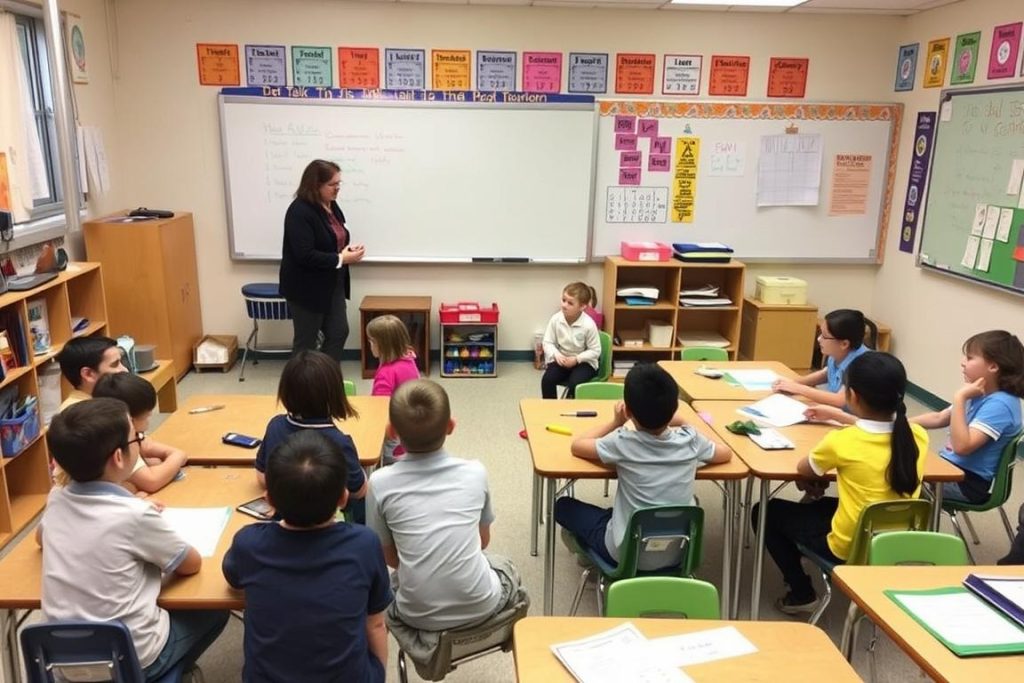
Learning Stations and Centers
Learning stations allow students to rotate through different activities at their own pace, providing opportunities for varied approaches to learning the same content.
“The best differentiation strategies are the ones that allow students to make choices about their learning while still ensuring they master essential content and skills.”
To implement effective learning stations:
- Design 4-6 stations that address the same learning objectives in different ways
- Include a mix of teacher-led, collaborative, and independent activities
- Provide clear instructions at each station
- Consider having “must-do” and “may-do” stations
- Include self-assessment components at each station
Tiered Activities
Tiered activities provide multiple versions of a task at different levels of complexity while focusing on the same essential understanding or skill.
| Tier | Description | Example: Math Problem-Solving |
| Tier 1 | Concrete application with scaffolding | Solve word problems with visual supports and sentence frames |
| Tier 2 | Grade-level application | Solve multi-step word problems independently |
| Tier 3 | Advanced application with greater complexity | Create and solve original problems that apply the concept |
Think-Pair-Share Variations
This simple but effective strategy can be differentiated in multiple ways:
- Think-Write-Pair-Share: Adds a writing component for students who process better through writing
- Think-Draw-Pair-Share: Incorporates visual representation for visual learners
- Think-Choose-Pair-Share: Allows students to select from multiple prompts based on interest or readiness
This video demonstrates several process differentiation strategies in action, including flexible grouping and tiered activities.
Product Differentiation Strategies for Meaningful Assessment
Product differentiation involves providing students with multiple ways to demonstrate their learning. This approach recognizes that students have different strengths and preferences for showing what they know.
Choice Boards and Learning Menus
Choice boards (also called learning menus or tic-tac-toe boards) offer students options for demonstrating mastery of content. They typically include a variety of product options that appeal to different learning preferences and strengths.
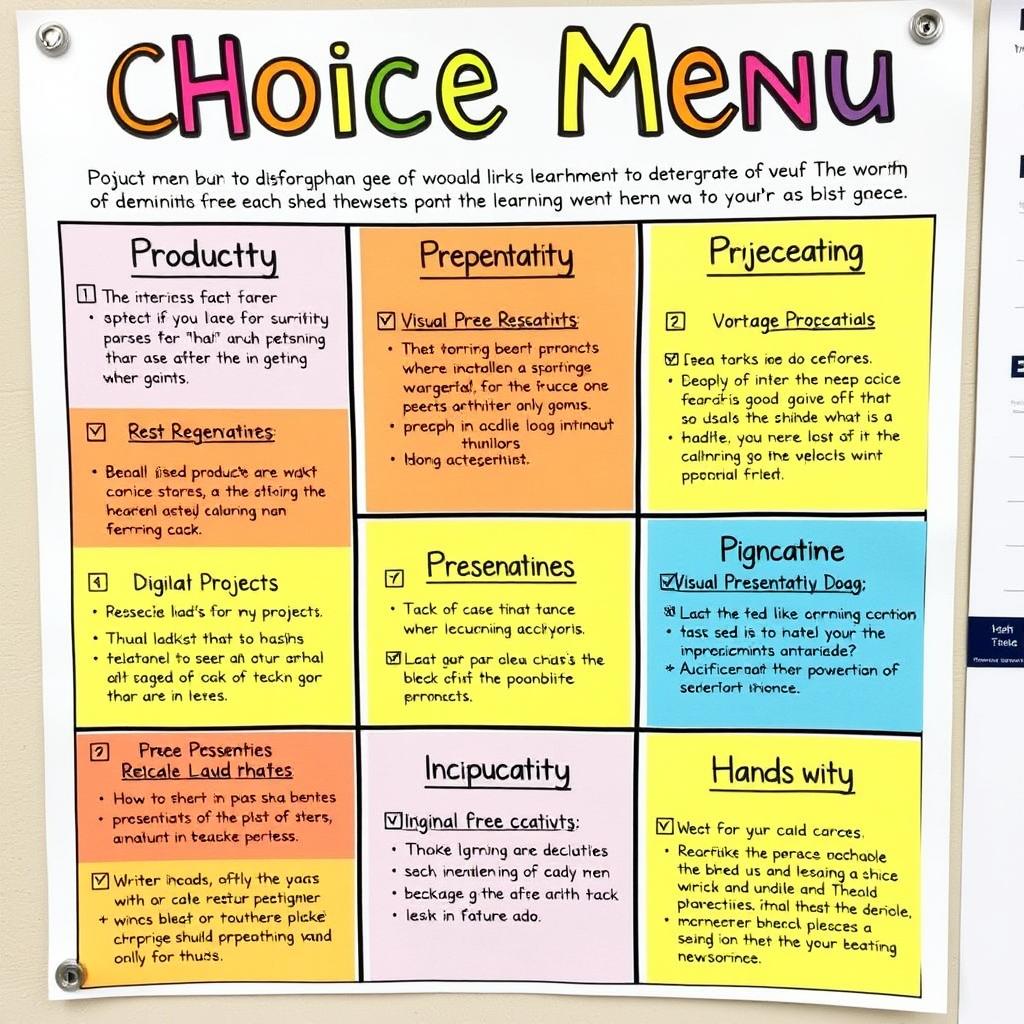
When creating choice boards:
- Ensure all options address the same essential learning standards
- Include a mix of product types (written, visual, oral, multimedia)
- Consider varying the complexity of different options
- Provide clear guidelines and rubrics for each option
- Allow students to propose their own product ideas that meet the criteria
RAFT Assignments
RAFT (Role, Audience, Format, Topic) assignments allow students to demonstrate learning by taking on different perspectives and creating products for specific audiences.
| Element | Description | Examples |
| Role | Who the student is as a writer | Scientist, historical figure, character from literature |
| Audience | Who will receive the communication | General public, younger students, government officials |
| Format | The form the writing will take | Letter, podcast script, newspaper article, social media posts |
| Topic | The subject being addressed | Specific content from the unit of study |
RAFT assignments can be differentiated by:
- Offering roles of varying complexity
- Providing more structured templates for some students
- Allowing choice within categories
- Adjusting expectations for depth and detail
Tiered and Scaffolded Assessments
Just as activities can be tiered, so can assessments. This approach maintains high expectations while providing appropriate levels of challenge and support.
Benefits of Tiered Assessments
- Allows all students to demonstrate mastery at appropriate levels
- Provides appropriate challenge for all learners
- Gives students choice and agency
- Creates more accurate picture of student understanding
Challenges to Address
- Ensuring all versions assess the same essential standards
- Managing multiple assessment versions
- Communicating the purpose to students and parents
- Maintaining high expectations for all students
Digital Tools for Product Differentiation
Technology offers numerous options for students to create diverse products:
Presentation Tools
Multimedia Creation
Learning Environment Differentiation Strategies
The learning environment encompasses both the physical space and the psychological atmosphere of the classroom. Differentiating the learning environment can significantly impact student engagement and success.
Physical Space Differentiation
Creating a flexible physical environment supports different learning needs and activities:
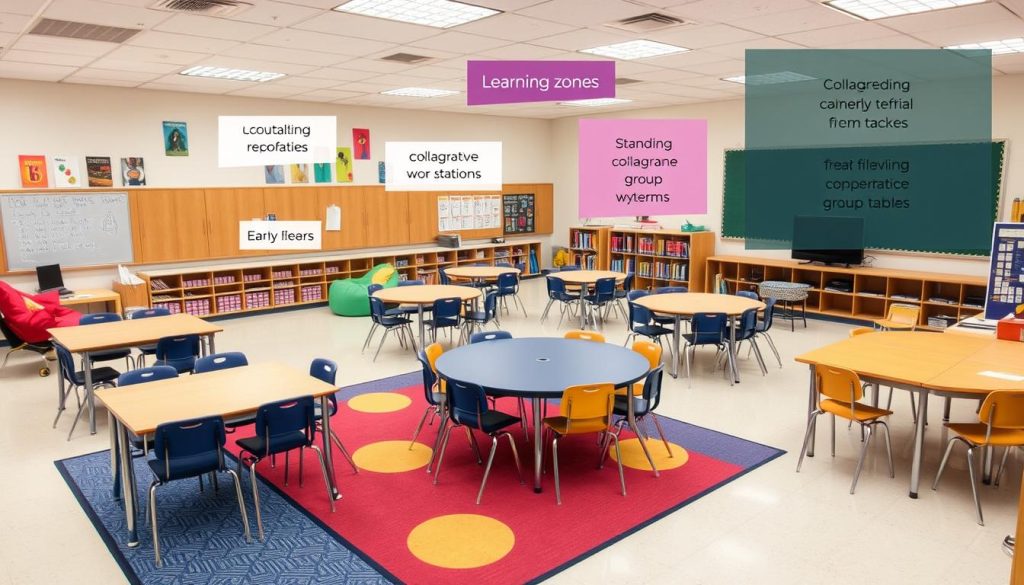
- Flexible Seating: Provide various seating options (traditional desks, standing desks, floor seating, stability balls) to accommodate different learning preferences
- Learning Zones: Create designated areas for different activities (quiet reading corner, collaboration space, technology station)
- Sensory Considerations: Offer noise-reducing headphones, fidget tools, and lighting options for students with sensory sensitivities
- Resource Access: Ensure materials are organized and accessible at different levels for student independence
Psychological Environment Differentiation
The emotional climate of the classroom is equally important for differentiation:
“In a differentiated classroom, the teacher proactively plans and carries out varied approaches to content, process, and product in anticipation of and response to student differences in readiness, interest, and learning needs.”
Carol Ann Tomlinson
Key elements of a supportive psychological environment include:
- Growth Mindset Culture: Emphasize effort, progress, and learning from mistakes
- Clear Routines with Flexibility: Establish predictable structures that also allow for individual needs
- Celebration of Diversity: Recognize and value different strengths, backgrounds, and perspectives
- Student Agency: Provide appropriate choices and opportunities for self-direction
Classroom Management for Differentiated Instruction
Effective differentiation requires thoughtful classroom management approaches:
Clear Expectations
Establish and communicate clear guidelines for different types of activities and transitions between them.
Visual Supports
Use visual schedules, task cards, and anchor charts to help students work independently.
Attention Signals
Develop consistent signals for gaining attention during varied activities.
Consider implementing these management strategies:
- “Ask Three Before Me”: Encourage students to seek help from peers before the teacher
- Task Boards: Display current activities and expectations for different groups
- Help System: Create a way for students to signal they need assistance without interrupting others
- Self-Regulation Tools: Teach and provide access to strategies for managing attention and emotions
Technology-Driven Differentiation Strategies for the Digital Age
Technology offers powerful tools for implementing differentiation strategies efficiently and effectively. When thoughtfully integrated, digital tools can help personalize learning while managing the complexity of a differentiated classroom.
Adaptive Learning Platforms
Adaptive learning platforms automatically adjust content and activities based on student performance:

Digital Formative Assessment Tools
These tools provide quick feedback to inform differentiation decisions:
- Plickers – Allows for quick checks without requiring student devices
- Socrative – Offers various question types and instant results
- Pear Deck – Integrates with presentation slides for interactive assessment
- Formative – Enables real-time monitoring of student work
Digital Content Curation
Tools for organizing and sharing differentiated digital resources:
Content Organization
- Symbaloo – Visual bookmarking tool
- Wakelet – Content curation platform
- LiveBinders – Digital three-ring binders
Learning Management
- Google Classroom – Assignment distribution and management
- Seesaw – Digital portfolio and assignment platform
- Canvas – Comprehensive learning management system
Best Practices for Technology Integration
To effectively use technology for differentiation:
- Start small with one or two tools that address specific differentiation needs
- Focus on tools that provide actionable data to inform instruction
- Ensure technology enhances rather than replaces quality teaching
- Provide clear instructions and support for technology use
- Consider equity and access issues when selecting digital tools
Tech Tip: When introducing new technology tools, consider using the “I Do, We Do, You Do” approach to ensure all students can access and use the tools effectively, regardless of their technology comfort level.
Overcoming Common Challenges in Implementing Differentiation Strategies
While differentiation strategies offer significant benefits, educators often face challenges in implementation. Addressing these challenges proactively can help make differentiation more manageable and effective.
Time and Planning Constraints
Solutions
- Start small with one subject or unit
- Use ready-made differentiated resources
- Develop a bank of tiered activities over time
- Collaborate with colleagues to share planning
- Implement student choice to reduce teacher preparation
Challenge
Many teachers cite lack of planning time as the biggest barrier to differentiation. Creating multiple versions of lessons and materials can seem overwhelming.
Classroom Management Concerns
Solutions
- Establish clear routines and expectations
- Teach students to work independently
- Use visual cues and directions
- Implement peer support systems
- Start with structured differentiation approaches
Challenge
Managing multiple activities simultaneously can create concerns about noise, movement, and ensuring all students remain on task.
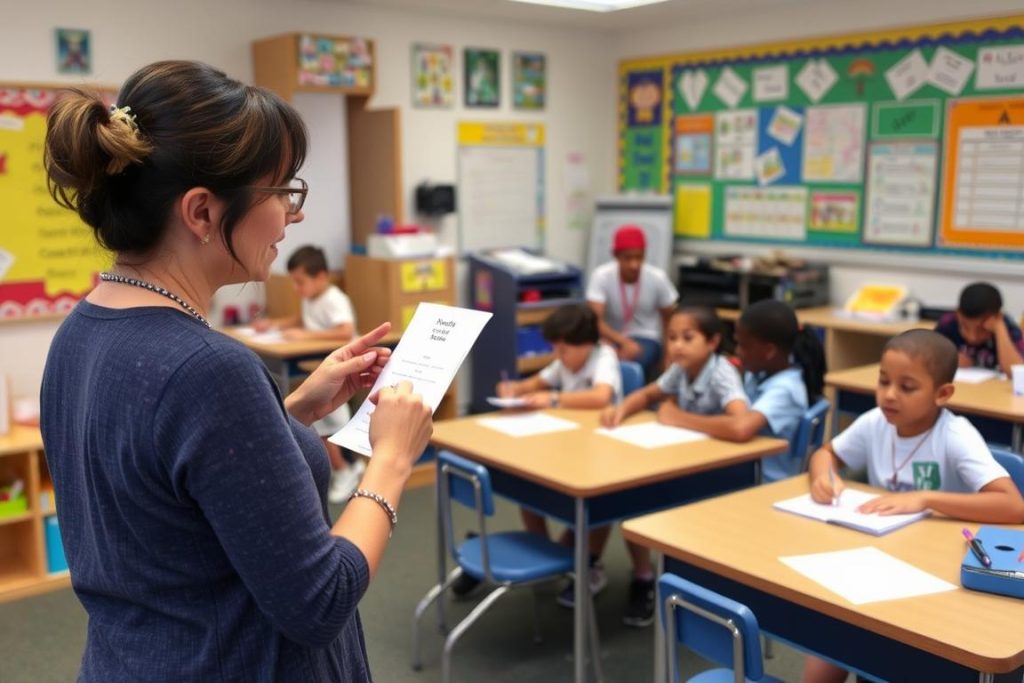
Assessment and Grading Complexities
Solutions
- Use standards-based grading focused on mastery
- Develop clear rubrics that allow for different paths to mastery
- Implement portfolio assessment approaches
- Separate formative and summative assessments
- Communicate grading approaches clearly to students and parents
Challenge
When students complete different activities or assessments, questions arise about fair and consistent grading practices.
Parent and Student Misconceptions
Solutions
- Communicate the purpose and benefits of differentiation
- Emphasize that differentiation is about providing appropriate challenge for all
- Share research on the effectiveness of differentiated instruction
- Involve students in understanding their learning needs
- Highlight growth and progress for all students
Challenge
Parents and students may perceive differentiation as unfair or as tracking students into fixed ability groups.
“Differentiation is classroom practice that looks eyeball to eyeball with the reality that kids differ, and the most effective teachers do whatever it takes to hook the whole range of kids on learning.”
Carol Ann Tomlinson
Getting Started with Differentiation Strategies: A Step-by-Step Approach
Implementing differentiation strategies doesn’t have to be overwhelming. Start with these manageable steps to gradually build your differentiation practice.
Step 1: Know Your Students
Begin by gathering information about your students‘ readiness, interests, and learning preferences:
- Administer simple interest surveys
- Conduct pre-assessments on upcoming content
- Observe students during different types of activities
- Review previous assessment data and work samples
- Have one-on-one conversations with students about their learning

Step 2: Start with One Differentiation Strategy
Choose one approach to try first, based on your teaching style and student needs:
Choice Boards
Create a simple 3×3 grid of activity options related to your current unit. Allow students to choose activities that interest them.
Tiered Tasks
Take one lesson and create two versions—one with more scaffolding and one with more complexity—based on student readiness.
Flexible Grouping
Plan one lesson where students work in different groupings based on readiness, interest, or learning preference.
Step 3: Plan and Prepare
- Identify the essential learning outcomes all students need to master
- Determine how you will pre-assess student readiness
- Decide how you will group students or differentiate tasks
- Prepare necessary materials and resources
- Create clear instructions and success criteria for all activities
Step 4: Implement and Reflect
As you implement your differentiation strategy:
- Explain the purpose to students
- Start with structured activities and clear expectations
- Observe what works and what doesn’t
- Ask for student feedback
- Make adjustments as needed
Remember: Differentiation is a journey, not a destination. Start small, reflect on your practice, and gradually expand your differentiation toolkit as you and your students become more comfortable with the approach.
Step 5: Expand Your Practice
Once you’re comfortable with one approach, gradually add new differentiation strategies:
- Try differentiating in another subject area
- Add a new differentiation strategy to your repertoire
- Incorporate technology tools to support differentiation
- Collaborate with colleagues to share ideas and resources
- Seek professional development to deepen your understanding
Conclusion: Embracing Differentiation as a Mindset
Differentiation strategies are not just techniques to be applied occasionally—they represent a fundamental shift in how we approach teaching and learning. At its core, differentiation is about truly seeing each student as an individual with unique needs, strengths, and interests, and then responding to those differences in ways that maximize learning for all.
As you implement the strategies discussed in this guide, remember that effective differentiation:
- Is proactive rather than reactive
- Is rooted in ongoing assessment and adjustment
- Provides multiple paths to the same essential understandings
- Maintains high expectations for all students
- Balances group and individual needs
The journey toward effective differentiation is ongoing and evolving. Start small, celebrate successes, learn from challenges, and continue to refine your approach. The impact on student engagement, achievement, and love of learning will be well worth the effort.
“In the end, all learners need your energy, your heart, and your mind. They have that in common because they are young humans. How they need you, however, differs. Unless we understand and respond to those differences, we fail many learners.”
Carol Ann Tomlinson
We encourage you to try at least one new differentiation strategy in your classroom this week. Start where you are, use what you have, and do what you can. Your students will benefit from even small steps toward more responsive, personalized instruction.
Share Your Differentiation Journey
We’d love to hear about your experiences implementing differentiation strategies in your classroom as you expand your professional development. What’s working? What challenges are you facing? Connect with other educators to share ideas and resources.

